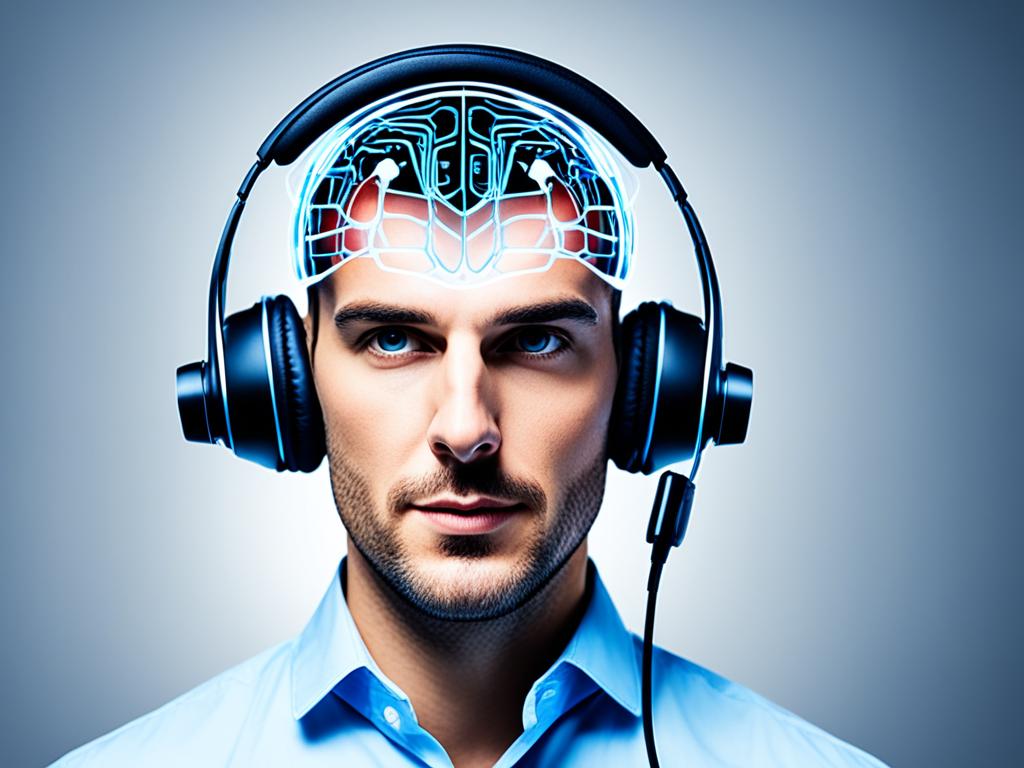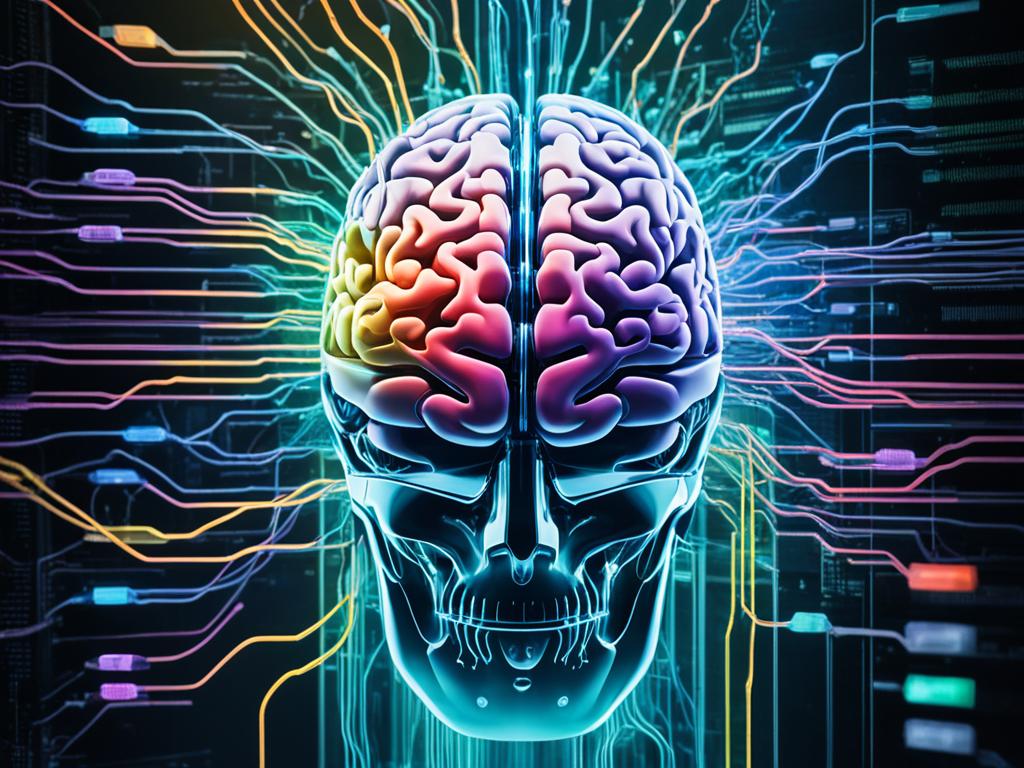Brain-computer interfaces, or BCIs, let people communicate with machines straight from their thoughts. This means users can guide computers, robotic arms, and more just by thinking.1 Researchers began exploring BCIs in the 1970s. They found that brain signals could move cursors and control different gadgets.1 Since then, BCI technology has advanced a lot. Now, we have ways to measure brain activity that don’t even need to touch the brain.1 BCI could change many things, from helping people with disabilities to working with AI.
Let’s dive into how brain-computer interfaces work, the kinds that exist, and what they’re used for. We’ll also check out all the new things happening in this area and what might come next.
Key Takeaways
- Brain-computer interfaces (BCIs) let us talk to machines with our minds. This lets users manage computers, artificial limbs, and more just with their thoughts.
- BCI research started in the 1970s and has since seen big steps in how we measure and understand brain activity, both with and without surgery.
- BCIs could change whole industries, like making life better for people who need assistive tech or combining brain and computer might with AI.
- BCIs have a lot of cool uses, from gaming to helping people with severe disabilities live more independent lives.
- As BCIs get better, they might let us do even more, like move with the help of devices that help overcome spinal cord injuries.
What Are Brain-Computer Interfaces?
Definition and Basic Concepts
A brain-computer interface (BCI) is like a shortcut between our brain and a computer.1 It lets us use our thoughts to control gadgets, like computers or robotic arms. BCIs detect the electrical signals in our brain and change them into commands that machines can understand. To do this, they use ways to measure our brain’s activity.
These methods include electroencephalography (EEG) to magnetic resonance imaging (fMRI). Through advanced signal processing, they can figure out what we want to do by looking at our brain’s signals.
Historical Development of BCI Technology
The story of BCIs goes back to the 1970s. That’s when scientists first proved that we could use brain signals to control things around us.1 Early work, like Vidal J.J.’s in 1973, showed that even animals could control simple devices with their brains.
In the 1980s, Elbert T., Farwell L.A., and Donchin E. pushed BCI research further. They used brain signals related to specific events, such as the P300 signal, to communicate with computers.1 Between the 1990s and 2000s, researchers like Wolpaw J.R. and Hochberg L.R. greatly improved BCI technology. They made it possible for people to control cursors and robotic arms, helping those with disabilities.
Today, BCI tech is still getting better. We continue to find new ways, both inside and outside the body, to use our brain signals to interact with the world.
Brain-Computer Interfaces: How They Work and Their Potential
Brain-computer interfaces (BCIs) work by picking up on the brain’s electrical signals. These signals come from neurons. Then, they are processed and understood. After that, they’re turned into orders that devices can follow.1 Let’s look at how this happens in steps:
- Neural Activity Measurement: BCIs use different methods to see what the brain is doing. For example, they might use electroencephalography (EEG), electrocorticography (ECoG), or functional magnetic resonance imaging (fMRI) to check on brain activities.1
- Signal Processing: The information captured by these methods is then run through special programs. These programs pick out important parts, like key patterns, from the data.1
- Neural Decoding: Using advanced methods such as machine learning and artificial intelligence, researchers decode this processed data. They translate it into actions for devices. These actions can be anything from moving a robotic arm to typing on a computer.1
This basic idea behind BCIs is leading to all kinds of new uses. These new uses can change fields such as helping people with disabilities and merging our thoughts with artificial intelligence.12
| BCI Statistical Data | Value |
|---|---|
| Number of papers | 521 |
| Significant publication year | 20121 |
| Average year of publication | 19901 |
| Average number of authors per paper | 31 |
Types of Brain-Computer Interfaces
Invasive BCIs
Invasive brain-computer interfaces are surgically implanted in the brain.3 They use electrodes or sensors placed within or on the brain.4 This direct contact with brain tissue allows for more precise signals.3 It helps decode actions accurately, offering advanced control.3 Yet, surgery is risky and complex.4 These BCIs are mainly for medical use. They help those with neurological issues regain movement or communication.3
Non-Invasive BCIs
Non-invasive brain-computer interfaces don’t need surgery.4 They use external devices to measure brain activity. This method is safer and easier but offers lower quality signals.3 The common approach is electroencephalography (EEG). It places electrodes on the scalp to capture signals.4 Other methods include fMRI and NIRS.4 They focus on blood flow and oxygen, respectively. Non-invasive BCIs are used in gaming, virtual reality, and rehab. They make interactions with technology more natural.3

Measuring Brain Activity for BCIs
Electroencephalography (EEG) is a key method for studying brain activity in non-invasive brain-computer interfaces. It works by placing electrodes on the scalp. We use these to catch the electricity in the brain’s neural activity. This electricity, called brain waves, falls into different types like alpha, beta, and gamma. By figuring out these types, we can understand what someone is thinking or trying to do.1 EEG-based systems are pretty cheap, easy to carry around, and simple to use. Because of this, they’re great not just for games and virtual worlds but also for helping people in need and recovering from injuries. Even though EEG is top-notch for many uses, the data it gives is not the best quality. That’s because the signals have to travel through skin and skull before we can see them.5
Electrocorticography (ECoG)
Electrocorticography (ECoG) is a technique that’s a bit more intrusive. It measures brain activity by attaching electrodes right on the brain’s surface. This can give much clearer information since there’s no barrier from the skull and skin.5 ECoG-based systems can pick up brain signals in more detail and quicker. This lets us achieve finer control and more functions. But, setting up ECoG needs surgery. This is more risky and is often done for serious health needs. For example, it helps people who can’t easily move or talk because of serious health issues.1
Functional Magnetic Resonance Imaging (fMRI)
Functional Magnetic Resonance Imaging (fMRI) is a way to look at the brain without going inside it. It looks at how the brain uses oxygen in different parts. This is linked to how active these parts are. Instead of tracing the brain’s electricity, like EEG does, fMRI watches how blood flow and oxygen change in the brain. Even though fMRI is not as direct, it gives a very detailed picture.5 In experiments, fMRI has let people control machines or computers just by thinking. But fMRI is too big and expensive for most places outside a lab. It’s also not as fast as other methods.1
Signal Processing and Neural Decoding
Brain-computer interfaces (BCIs) work well when they can read and understand brain signals accurately. Signal processing and neural decoding take these signals and turn them into controls for devices.6
Techniques like spatial filtering and modeling help make sense of brain signals.6 These methods make it easier to see different patterns of brain activity, making BCIs more trustworthy.6
Neural decoding uses learning and AI to change brain signals into commands for machines.6 It’s found that specific patterns of brain activity, like low-power neuronal activity, can particularly boost BCI performance.7
Some systems, like intracortical BCIs, quickly adjust to users with limited movement. Others, like sensorimotor neural interfaces, bring back the ability to feel touch.7 They’ve even managed to decode complex movements and brain signals directly.7
Advances in these fields are making BCIs better in many ways. They help in more than just movement control, from helping those with disabilities to steering robots.76

Applications of Brain-Computer Interfaces
Brain-computer interfaces help disabled individuals. They improve life quality for people with paralysis, ALS, or severe movement issues.8 Only a few dozen people globally have received BCIs, and these are experimental.8 BCI research has picked up since the 21st century began, leading to thousands of new studies.8 For the first time in April 2021, the FDA approved a wearable BCI for rehabilitation.8
Robotic and Prosthetic Control
BCIs are also vital in controlling robots and prosthetic devices. They let users direct robotic limbs or exoskeletons with their minds.8 BCIs, both wearable and implanted, are undergoing trials for medical applications.8
Communication and Computer Access
In the area of communication and using computers, BCIs are essential. They are especially crucial for those with severe movement or neurological issues.9 The cost of wearable BCIs varies greatly, from hundreds to thousands of dollars, affecting their use.8 Using BCIs effectively often needs a lot of training.8 There’s also a concern about cyberattacks targeting BCIs, which might risk revealing brain data or disrupt the device’s function.8
Challenges and Limitations of BCIs
Brain-computer interface (BCI) tech has come a long way, but several hurdles still remain. A big issue is the signal quality and accuracy. Brain signals, though amazing, are often noisy and varied. This messes with how well BCI systems work.10 A study by Abiri et al. (2019) looked at EEG-based BCIs. It showed efforts to make signals clearer and adapt BCIs to different users.10 Different brain makeups and thinking skills cause more trouble. They make finding a one-size-fits-all BCI hard.
User Training and Adaptation
Getting users to work well with BCIs is tough. Keyboards and mice are easy to use because we’re familiar with them. But BCIs are a whole new game, asking us to control things with our thoughts.10 A 2008 study by Hoffmann and team explained how to train people with BCIs. It emphasized that training and the brain’s ability to change are key.10 Some are looking into using BCIs for those who can’t easily use traditional tech. This shows how important personal training and smart system adjustments are.10 The BCI field is growing fast. Solving these training and user-adaptation issues is vital for it to reach its full potential.
Source Links
- https://www.ncbi.nlm.nih.gov/pmc/articles/PMC3497935/
- https://computer.howstuffworks.com/brain-computer-interface.htm
- https://builtin.com/hardware/brain-computer-interface-bci
- http://learn.neurotechedu.com/introtobci/
- https://cumming.ucalgary.ca/research/pediatric-bci/bci-program/what-bci
- https://digital-library.theiet.org/content/books/ce/pbce114e
- https://www.ncbi.nlm.nih.gov/pmc/articles/PMC10380541/
- https://www.gao.gov/products/gao-22-106118
- https://www.ncbi.nlm.nih.gov/pmc/articles/PMC2862632/
- https://www.ncbi.nlm.nih.gov/pmc/articles/PMC10403483/


